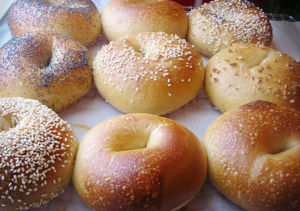Bagel: Difference between revisions
imported>Eric Clevinger (added image, rewrote some of the article.) |
Pat Palmer (talk | contribs) m (Text replacement - "New York City" to "New York City") |
||
| Line 2: | Line 2: | ||
{{Image|Bagel.jpg|right|300px|A tray of bagles in various types.}} | {{Image|Bagel.jpg|right|300px|A tray of bagles in various types.}} | ||
A '''bagel''' is a bread dough roll, unusual both in shape and cooking technique. It is formed into a doughnut- or toroidal shape with a hole in the center, boiled, often glazed, and then baked. There are many variants, but it is often considered part of [[Jewish-American cuisine]]. It originated in Eastern Europe, but the American bagel industry formally began in [[New York City]], with the formation of Bagel Bakers Local #338 in 1909. | A '''bagel''' is a bread dough roll, unusual both in shape and cooking technique. It is formed into a doughnut- or toroidal shape with a hole in the center, boiled, often glazed, and then baked. There are many variants, but it is often considered part of [[Jewish-American cuisine]]. It originated in Eastern Europe, but the American bagel industry formally began in [[New York, New York|New York City]], with the formation of Bagel Bakers Local #338 in 1909. | ||
Bagel dough contains little to no fat, so stale bagels become very hard. Well into the 1960s, it was unusual to find other than plain or egg dough, possibly with coverings of [[poppy seed]], [[onion]] slivers, or [[sesame seed]]. As it has become more a part of mainstream American cuisine, there are many more variations, including sweet doughs, with chocolate, fruits, and nuts. | Bagel dough contains little to no fat, so stale bagels become very hard. Well into the 1960s, it was unusual to find other than plain or egg dough, possibly with coverings of [[poppy seed]], [[onion]] slivers, or [[sesame seed]]. As it has become more a part of mainstream American cuisine, there are many more variations, including sweet doughs, with chocolate, fruits, and nuts. | ||
Traditional condiments include [[cream cheese]], [[butter]], or [[cream cheese]] with smoked fish such as [[lox (food)|lox]] or [[smoked sturgeon]]. Due to the center hole, bagels can be messy when used as the base of [[sandwich]]es. | Traditional condiments include [[cream cheese]], [[butter]], or [[cream cheese]] with smoked fish such as [[lox (food)|lox]] or [[smoked sturgeon]]. Due to the center hole, bagels can be messy when used as the base of [[sandwich]]es. | ||
Revision as of 09:17, 8 April 2023
A bagel is a bread dough roll, unusual both in shape and cooking technique. It is formed into a doughnut- or toroidal shape with a hole in the center, boiled, often glazed, and then baked. There are many variants, but it is often considered part of Jewish-American cuisine. It originated in Eastern Europe, but the American bagel industry formally began in New York City, with the formation of Bagel Bakers Local #338 in 1909.
Bagel dough contains little to no fat, so stale bagels become very hard. Well into the 1960s, it was unusual to find other than plain or egg dough, possibly with coverings of poppy seed, onion slivers, or sesame seed. As it has become more a part of mainstream American cuisine, there are many more variations, including sweet doughs, with chocolate, fruits, and nuts.
Traditional condiments include cream cheese, butter, or cream cheese with smoked fish such as lox or smoked sturgeon. Due to the center hole, bagels can be messy when used as the base of sandwiches.
